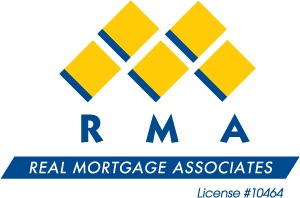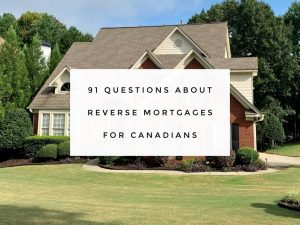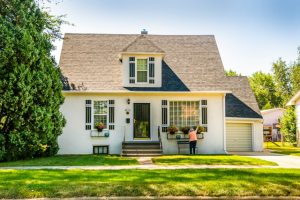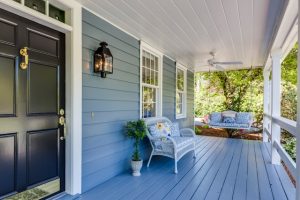What is a reverse mortgage, and could it be a wise addition to your retirement plan?
A reverse mortgage lets homeowners aged 55 and older tap into their home equity to acquire cash without having to move out. This introduction aims to provide you with an honest overview of reverse mortgages, outlining how they function and the consequences for your financial assets, which is essential before considering such a pivotal financial move.
Demystifying Reverse Mortgages
Let’s start by demystifying what reverse mortgages are. Primarily designed as a financial relief for retirees, a reverse mortgage loan allows homeowners to borrow money from their home equity without having to sell the home. If you’re considering this option, it’s essential to understand how to get a reverse mortgage.
The homeowner’s age, the home’s condition, type, and appraised value, as well as the lender, influence the amount available in a reverse mortgage. In Canada, homeowners must be at least 55 years old to qualify for a reverse mortgage, while in the United States, the government mandates that borrowers must be 62 years or older.

A reverse mortgage means you don’t have to choose between staying in your family home and keeping up with inflation
The funds from a reverse mortgage can be used for various purposes like home repairs, healthcare expenses, or repaying debts, and it’s crucial to inquire with the lender about any restrictions or fees. The home used for a reverse mortgage must typically be the primary residence, meaning the homeowner lives there for at least six months a year.
Now, you might wonder – why is there an age requirement? Well, the age requirement ensures that homeowners have had enough time to build substantial equity in their homes, necessary for borrowing through a reverse mortgage. Furthermore, it helps protect lenders who provide the ‘negative equity guarantee,’ ensuring the loan is typically repaid before the balance exceeds the home’s value.
Important details we’ll cover:
Before diving into the nitty-gritty of reverse mortgages, let’s outline some key features that we’ll cover. To qualify for a reverse mortgage, homeowners must meet certain age requirements, typically being at least 62 years old. One of the significant advantages of reverse mortgages is the flexible payment options they offer. Borrowers can receive funds as a lump sum, line of credit, or regular payments, catering to varied financial needs without requiring regular loan repayments.
The repayment of a reverse mortgage is deferred until the homeowner moves out, sells the home, or passes away, with certain products allowing up to 10% of the balance to be prepaid each year without penalties.
Reverse Mortgage vs. Traditional Mortgage
So, how does a reverse mortgage differ from a traditional forward mortgage? A traditional forward mortgage is typically used to purchase a home, while a reverse mortgage is designed to provide income by allowing homeowners to access accumulated home equity. Forward mortgages operate under the assumption that real estate value increases over time which builds home equity, which in turn is what reverse mortgages draw upon to provide funds to borrowers.
However, unlike a forward mortgage where borrowers consistently make monthly mortgage payments to repay the loan over a set period, reverse mortgages do not require monthly payments. Instead, the loan balance becomes due when the borrower passes away, sells the home, or permanently moves out. This fundamental difference makes reverse mortgages an attractive option for many homeowners nearing or in retirement, and understanding how a reverse mortgage works and the reverse mortgage contract is essential.
Types of Reverse Mortgages and How Reverse Mortgages Work

Learn how reverse mortgages work in Canada
Now that we’ve covered the basics, let’s delve into the different types of reverse mortgages. The three main types of reverse mortgage loans are single-purpose, federally insured, and proprietary. The funds from these must be utilized for specific purposes approved by the lender, such as home repairs or paying property taxes.
Home Equity Conversion Mortgages (HECMs) are the most common type of federally insured reverse mortgages, supported by the U.S. Department of Housing and Urban Development (HUD). On the other side of the spectrum, proprietary reverse mortgages, offered by private lenders, are beneficial for those who own higher-valued homes that exceed federal limits for HECMs. Unlike HECMs, proprietary reverse mortgages don’t require up-front or monthly mortgage insurance premiums, which may result in borrowers receiving more funds.
Understanding the nuances of each type can help you decide which reverse mortgage suits your needs best. Whether you opt for a single-purpose, federally insured, or proprietary reverse mortgage, it’s vital to be aware of the unique considerations associated with each.
Home Equity Conversion Mortgage (HECM)
Let’s take a closer look at the Home Equity Conversion Mortgage (HECM), the most common type of reverse mortgage in the United States, accounting for about 90% of all reverse mortgages. These loans are available to individuals who are at least 62 years old, and they offer multiple payout options for borrowers, including lump sum, regular monthly payments, and lines of credit. One of the most significant advantages of HECMs is their non-recourse nature, ensuring that borrowers or their estates won’t owe more than the home’s value at the time of sale. Considering a reverse mortgage early in the process can help borrowers make informed decisions about their home equity options.
Borrowers can use HECM proceeds to purchase a new primary residence, provided they can cover the difference between the HECM funds and the home’s sales price and closing costs. Prospective HECM borrowers must undergo counseling from a HUD-approved agency to understand the loan’s terms and obligations fully. The total amount available to a borrower through a HECM is calculated using the home’s value, the borrower’s age, interest rates, and HUD’s Principal Limit factors.
Canadian Reverse Mortgages
In Canada, homeowners 55 years or older can access up to 55% of their home’s value through a reverse mortgage. HomeEquity Bank and Equitable Bank are the primary providers of reverse mortgages in Canada, including the popular chip reverse mortgage product. Canadian reverse mortgage borrowers can choose to receive funds in a lump-sum, regular installments, or a mix of both, typically $1,000 monthly or $3,000 quarterly, often alongside an initial lump-sum payment. Both HomeEquity Bank’s CHIP and Equitable Bank’s Flex reverse mortgage products ensure that borrowers’ debt will not exceed the market value of their home, irrespective of the amount of accrued interest.
Understanding these specifications can help Canadian homeowners make an informed decision about homeowners insurance.
Evaluating Reverse Mortgage Lenders

Make the most of every moment of your retirement with income from a reverse mortgage.
Choosing the right lender is as crucial as understanding the type of reverse mortgage that suits you best. Rates and fees can vary widely among reverse mortgage lenders, making it advisable for borrowers to shop around for the best options. Considering the types of loan options offered by reverse mortgage lenders is crucial to ensure they match the homeowner’s needs.
Moreover, evaluating reverse mortgage lenders’ customer service ratings and reviews, along with checking their standing with the Better Business Bureau, can provide insights into their credibility and treatment of customers. Working with lenders who are members of the National Reverse Mortgage Lenders Association offers additional assurance as they commit to a code of ethics regarding customer treatment. Homeowners should ensure they receive all necessary information to make an informed decision about a reverse mortgage.
Customer Reviews and Testimonials
Customer feedback enhances the trustworthiness of reverse mortgage lenders, allowing borrowers to avoid scams and opt for a credible provider. Reading lender reviews and checking with the Better Business Bureau are recommended actions to gauge customer satisfaction and discover any grievances or feedback regarding the lender.
Evaluating the reputation and service quality of reverse mortgage lenders can be accomplished by looking for online reviews or asking for personal recommendations from friends who have undergone the reverse mortgage process. Authentic customer reviews offer accounts of real-life experiences, which help potential borrowers gain insights into the complexities of reverse mortgages and the service levels provided by lenders.
Costs and Fees Associated with Reverse Mortgages

Balancing the Pros and cons of a reverse mortgage in Canada
Every financial decision comes with its costs, and reverse mortgages are no exception. A reverse mortgage involves a range of costs, such as:
- Origination fees
- Standard closing costs
- Ongoing mortgage insurance premiums
- Servicing fees
- Interest rates
It’s important to consider these costs before deciding if a reverse mortgage is the right option for you.
The ongoing costs of a reverse mortgage include:
- Interest
- An annual mortgage insurance premium
- Servicing fees
- Property charges such as insurance and taxes
All of these costs can lead to an increasing loan balance over time. Reverse mortgages can be more expensive than other types of loans due to high fees and ongoing costs, making it important to compare with alternatives such as traditional mortgages and home equity lines of credit.
To minimize costs, borrowers can choose to take out only the amount needed, as the best way to keep ongoing costs low is to borrow minimally, and use the loan proceeds to cover upfront costs.
Understanding Interest Rates
Let’s delve deeper into one of the most significant costs associated with reverse mortgages – the interest rates. Here are some key points to know about reverse mortgage interest rates:
- Reverse mortgage interest rates are typically higher than those for traditional mortgages or Home Equity Lines of Credit (HELOCs) due to the increased risk for lenders since no mortgage payments are required.
- Interest rates for reverse mortgages are calculated daily.
- Fixed rates are compounded semi-annually, while variable rates are compounded monthly.
- Interest is only charged on the amount actually borrowed, not the maximum borrowing limit.
Like a traditional mortgage, market interest rates change from time to time. Understanding the nature of these reverse mortgage rates can help potential borrowers make a more-informed decision and plan their finances accordingly.
Hidden Charges and Penalties
Beyond the common costs associated with reverse mortgages, it’s essential to be aware of potential hidden charges and penalties. Prepayment of a reverse mortgage loan may incur penalties, the specifics of which depend on the reverse mortgage program. Set-up fees, legal fees, closing costs, appraisal costs, and the expenses for Independent Legal Advice (ILA) collectively contribute to the additional financial burden on borrowers of reverse mortgages.
However, certain protections are in place, such as the right of rescission and the No Negative Equity Guarantee, to safeguard against unexpected costs.
Advantages and Disadvantages of Reverse Mortgages

Learn how reverse mortgages in Canada supplement retirement savings
As with any financial tool, reverse mortgages come with their own set of advantages and disadvantages. On the plus side, reverse mortgages can provide financial relief for retirees by enabling them to:
- Convert their home equity into spendable funds
- Live in their home without needing to sell it to access equity, maintaining their residence while benefiting financially
- Use the funds to eliminate existing mortgage debt, offering homeowners the opportunity to free up cash for other expenses.
However, one of the disadvantages of reverse mortgages in Canada is:
- the higher interest rates compared to other forms of borrowing
- the potential decrease in home equity over time, which could affect the value left to heirs
- the possibility of foreclosure if the homeowner defaults on property-related expenses
- The reduction of the home’s equity over time potentially leaves little to no inheritance for the homeowner’s heirs.
Financial Benefits
Despite the potential downsides, reverse mortgages offer several financial benefits. For starters, the reverse mortgage money received in Canada is not taxable, which preserves the homeowner’s overall tax burden. Receiving funds from a reverse mortgage does not impact eligibility for Old Age Security (OAS) or Guaranteed Income Supplement (GIS) benefits.
Moreover, homeowners can access up to 55% of their home’s value through a reverse mortgage, providing a significant increase in cash flow. Funds from a reverse mortgage can be used for a variety of purposes, such as:
- covering living expenses
- healthcare costs
- home improvements
- consolidating debts
Potential Risks
However, it’s crucial to be aware of the potential risks associated with reverse mortgages. Homeowners could face foreclosure if they fail to meet loan obligations such as pay property taxes, maintaining insurance, or upholding loan conditions. Accumulated interest on a reverse mortgage reduces home equity over time, which can lessen the amount left in the estate for heirs.
Heirs may be required to repay the reverse mortgage and accrued interest after the death of the homeowner, potentially necessitating the sale of the home. Furthermore, the rules and terms for repaying a reverse mortgage are often complex and repayment is typically required when the homeowner permanently leaves the home, sells it, or passes away.
In some cases, the loan balance of a reverse mortgage can grow to exceed the value of the home, but because of Canada’s “no negative equity guarantee,” if the loan exceeds the home value, it is the lender’s loss, not a debt to the heirs.
Considering these risks is crucial when getting a reverse mortgage and determining if it is the right choice for retirement planning.
Reverse Mortgage Alternatives
Before you make the leap into a reverse mortgage, it’s worth exploring some alternatives. Alternatives to reverse mortgages include:
- Home equity loans
- Home equity lines of credit (HELOC)
- Cash-out refinance loans
- Traditional refinance loans, which can lower monthly payments and free up cash.
Another option is downsizing or selling the home, which provides access to equity without the complexities of a reverse mortgage. The proceeds from the sale can then be used to buy a smaller, more affordable property or to rent. However, income from a reverse mortgage may affect eligibility for need-based government programs like Medicaid and Supplemental Security Income (SSI), which is an important consideration when exploring alternatives.
Home Equity Line of Credit (HELOC)
A HELOC, or Home Equity Line of Credit, allows homeowners to:
- Borrow a specific amount of money using the equity in their home as collateral
- Obtain flexible access to funds
- Use the funds for various purposes such as home improvements, debt consolidation, or emergencies
However, it’s important to note that obtaining a reverse mortgage may disqualify a homeowner from securing other financing options like a HELOC, which is secured by the home.
A HELOC is viewed as a more suitable option for individuals who require short-term cash, can make monthly repayments, and wish to leave their home to their heirs. HELOCs often have lower interest rates compared to reverse mortgages, which can influence a homeowner’s choice between these two options. The interest rates on a HELOC are variable, leading to potentially fluctuating monthly payments, which is different from the fixed-rate options of a home equity loan.
The lower interest rates and flexibility of a HELOC can provide financial benefits over a reverse mortgage, especially for those not seeking long-term solutions or looking to preserve inheritance.
Downsizing or Renting
Downsizing to a smaller home can be an effective alternative to a reverse mortgage, offering cash to fund retirement while retaining equity to pass on to heirs. Selling a larger home to purchase a smaller one can provide surplus funds that might be allocated to savings or other expenses, providing financial freedom and flexibility.
On the other hand, renting out the current home or moving to a rental property offers more flexibility and might lower housing-related costs, providing an alternative to the financial commitment of a reverse mortgage. For those concerned with legacy, downsizing could be more beneficial than a reverse mortgage, as it allows for retaining a property that may appreciate and be left as a part of an inheritance. However, downsizing may lead to a change in lifestyle, such as reduced living space and amenities which could influence home activities and socializing.
Also, it may be necessary to consider proximity to family, friends, or healthcare services when moving to a more affordable location, which can be a consequence of maximizing downsizing proceeds.
Making the Right Decision: Is a Reverse Mortgage Suitable for You?
So, is a reverse mortgage the right choice for your retirement plan? A reverse mortgage may be suitable for those needing to supplement limited income for unexpected expenses, signifying the need to assess one’s financial situation carefully. Decision-making for a reverse mortgage can be influenced by non-financial factors such as staying close to community, family, and friends.
A reverse mortgage provides retirement funding flexibility to manage finances and potentially avoid depleting other assets, while also funding plans like traveling. It’s also crucial to involve family in the decision-making process to avoid future surprises and to ensure all parties understand the financial implications of a reverse mortgage.
Before choosing a reverse mortgage, it’s essential to understand how they work and consider all pros and cons to make an informed decision.
Personal Financial Situation
Understanding your current financial situation, including:
- income
- expenses
- assets
- debts
is essential when assessing if a reverse mortgage fits your financial goals. Evaluating monthly income and expenses is critical for determining overall financial stability and can influence the decision to proceed with a reverse mortgage.
Assessing current debts and liabilities helps determine financial stability and eligibility for a reverse mortgage. The flexibility of reverse mortgages allows borrowers to choose how they access their funds, which should be tailored to individual financial needs and long-term income requirements.
Determining long-term financial goals is crucial when evaluating the suitability of a reverse mortgage and planning for a secure retirement. Funds received from a reverse mortgage are tax-free, which can be a significant advantage when managing financial plans in retirement.
Seeking Professional Advice
When exploring reverse mortgage options, it’s vital to seek professional advice. Here are some steps to take:
- Consult a financial professional to understand all aspects and obligations involved in a reverse mortgage.
- Seek independent legal advice to ensure you fully understand the legal implications.
- Take advantage of professional counseling services that can help with debt management, budget creation, and exploring financial assistance options relevant to reverse mortgages.
Counseling services provide homeowners with education and emotional support which is instrumental in developing coping strategies and financial resilience when considering a reverse mortgage.
How Do Reverse Mortgages Work in Canada: Summary
In conclusion, reverse mortgages can be an effective tool for homeowners looking to supplement their income during retirement. By leveraging the equity in their homes, homeowners can gain access to funds without selling their homes, thereby maintaining their lifestyle and sense of security. However, like any financial decision, it’s crucial to weigh the pros and cons, understand its costs, and explore alternatives.
Whether you’re considering a reverse mortgage, a HELOC, or downsizing, making an informed decision that aligns with your financial goals and retirement plans is important. Don’t hesitate to seek professional advice and involve your family in decision-making.
After all, your home is more than just an asset; it’s where your heart is.
Frequently Asked Questions
What is a reverse mortgage?
A reverse mortgage allows homeowners, usually aged 55 or older, to borrow money from their home equity without selling the home. It’s a loan option that provides financial flexibility in retirement. Have a question? We’d be happy to help you figure out it a reverse mortgage is right for you.
What are the types of reverse mortgages?
There are three main types of reverse mortgage loans: single-purpose, federally insured, and proprietary. Each type offers different features and benefits.
What are the potential costs of a reverse mortgage?
The potential costs of a reverse mortgage include origination fees, mortgage insurance premium, closing costs, servicing fees, and interest rates. It’s essential to consider these costs before deciding on a reverse mortgage.
What are the alternatives to a reverse mortgage?
Instead of a reverse mortgage, you could consider options such as home equity loans, HELOCs, cash-out refinance loans, or downsizing/selling your home as alternatives. Choose the option that best fits your financial situation.









